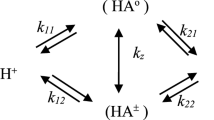Abstract
Solute–solvent interactions of l-aspartic acid and ethylenediamine have been studied in various concentrations (0–60 % v/v) of 1,2-propanediol–water mixtures maintaining an ionic strength of 0.16 mol l−1 at 303 ± 0.1 K using pH-metric method. The protonation constants have been calculated with the computer program MINIQUAD75. Selection of the best fit chemical model of the protonation equilibria is based on SD in protonation constants and residual analysis using crystallographic R-factor and sum of squares of residuals in all mass balanced equations. Linear variation of protonation constants with inverse of dielectric constants of the solvent mixture has been attributed to the dominance of the electrostatic forces. Distribution of species, protonation equilibria and effect of influential parameters on the protonation constants has also been presented.



Similar content being viewed by others
References
Babu MS, Rao GN, Ramana KV, Rao MSP (2000) Solvent effect on protonation equilibria of l-ornithine and l-glutamic acid. J Indian Chem Soc 77:380–385
Latha MP, Rao VM, Rao TS, Rao GN (2007) Determination of protonation constants of l-glutamic acid and l-methionine in 1,2-propanediol–water mixtures. Acta Chim Slov 54:160–165
Rao PS, Srikanth B, Rao VS, Sastry CK, Rao GN (2009) Protonation equilibria of l-aspartic, citric and succinic acids in anionic micellar media. Eur J Chem 6:561–568
Hine J (1975) Structural effects on equilibria in organic chemistry. Wiley, New York
Chen PE, Geballe MT, Stansfeld PJ, Johnston AR, Yuan H, Jacob AL, Snyder JP, Traynelis SF, Wyllie DJA (2005) Structural features of the glutamate binding site in recombinant NR1/NR2A N-methyl-d-aspartate receptors determined by site-directed mutagenesis and molecular modeling. Mol Pharmacol 67:1470–1484
Nelson DL, Cox MM (2000) Lehninger principles of biochemistry, 3rd edn. Worth Publishing, New York
Wang J, Wang J, Liu J, Wang S, Pei J (2010) Solubility of d-aspartic acid and l- aspartic acid in aqueous salt solutions from (293 to 343) K. J Chem Eng Data 55:1735–1738
Tapiero H, Mathe G, Couvreur P, Tew KD (2002) Glutamine and glutamate. Biomed Pharmacother 56:446–457
Kumar NV, Rao GN (2010) Influence of dielectric constant on protonation equilibria of l-aspartic acid in acetonitrile- and ethylene glycol–water mixtures. Acta Chim Slov 58:342–346
Eller K, Henkes E, Rossbacher R, Hoke H (2005) Ulmann’s encyclopedia of industrial chemistry. Wiley, Geneva
Paoletti P (1984) Formation of metal complexes with ethylenediamine: a critical survey of equilibrium constants, enthalpy and entropy values. Pure Appl Chem 56:491–497
Arash L, Habibi MH, Harrington RW, Morteza M, William C (2006) Synthesis, structural and spectroscopic properties of a new Schiff base ligand N,N′-bis (trifluoromethylbenzylidene) ethylenediamine. J Fluorine Chem 127:769–775
Bjerrum J (1950) On the tendency of the metal ions toward complex formation. Chem Rev 46:381–387
Everett DH, Pinsent BRW (1952) The dissociation constants of ethylenediammonium and hexamethylene diammonium Ions from 0° to 60 °C. Proc R Soc Lond 215:416–429
Kumar NV, Rao GN (2011) Effect of dielectric constant of medium on protonation equilibria of ethylenediamine. Chem Speciat Bioavail 23:170–174
Sigel H, Martin RB, Tribolet R, Haring UK, Balakrishnan RM (1985) An estimation of the equivalent solution dielectric constant in the active-site cavity of metalloenzymes dependence of carboxylate–metal-ion complex stabilities on the polarity of mixed aqueous/organic solvents. Eur J Biochem 152:187–194
Sengwa RJ, Chaudary R, Mehrotra SC (2001) Microwave dielectric relaxation study of poly(propylene glycol) in dilute solution. Mol Phys 21:1805–1812
Chandraleela A, Swarooparani R, Rao GN (2012) Solvent effect on protonation equilibria of l-aspartic acid and ethylenediamine in dioxan–water mixtures. Proc Natl Acad Sci India Sect A Phys Sci 82:197–204
Rao RS, Rao GN (2005) Computer applications in chemistry. Himalaya Publishing House, Mumbai, pp 277–351
Rao GN (1989) Complex equilibria of some biologically important metal ions in aquo—organic media. Ph. D. Thesis, Andhra University, Visakhapatnam
Gans P, Sabatini A, Vacca A (1976) An improved computer program for the computation of formation constants from potentiometric data. Inorg Chim Acta 18:237–239
Acknowledgments
RSR and ACL thank the University Grants Commission, Government of India, New Delhi for financial support.
Author information
Authors and Affiliations
Corresponding author
Rights and permissions
About this article
Cite this article
Swaroopa Rani, R., Chandra Leela, A. & Nageswara Rao, G. Effect of Dielectric Constant on Protonation Equilibria of l-Aspartic Acid and Ethylenediamine in 1,2-Propanediol–water Mixtures. Proc. Natl. Acad. Sci., India, Sect. A Phys. Sci. 82, 313–316 (2012). https://doi.org/10.1007/s40010-012-0047-3
Received:
Accepted:
Published:
Issue Date:
DOI: https://doi.org/10.1007/s40010-012-0047-3




